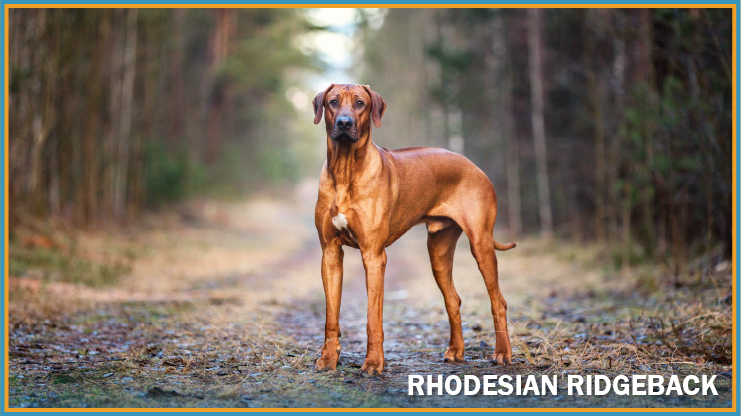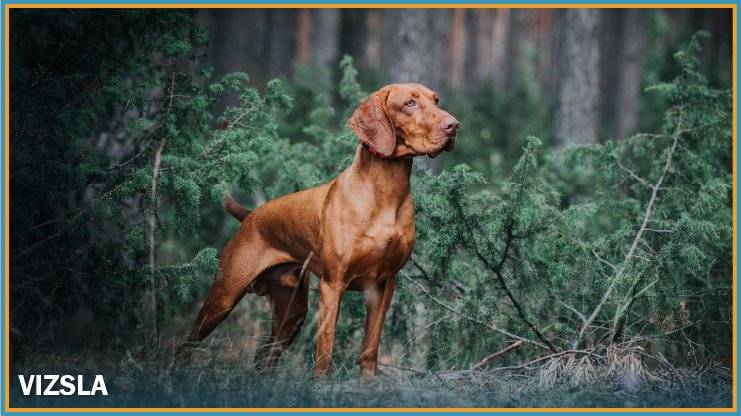
Rhodesian Ridgeback vs. Vizsla: Can You Tell Them Apart?
The Rhodesian Ridgeback and the Vizsla are two unique breeds with origins in very different parts of the world! Known for their distinct short-haired, red-colored coats, it’s easy to see how these dogs could be mistaken for one another. Yet, there are a few differences that help tell them apart if you know what to look for!
In the last breed comparison blog, we discussed the Golden Retriever vs. the Labrador Retriever. This time, we will consider the similarities and differences between the Rhodesian Ridgeback and the Vizsla. Let’s take a look!
A Brief History of the Rhodesian Ridgeback
An influx of European immigrants arrived in 16th and 17th-century southern Africa, bringing their language, customs, and dogs to the African veldt. The immigrants, primarily Dutch and German, settled alongside the Khoikhoi people. The cattle-herding Khoikhoi seasonally moved livestock from one grazing ground to another in the Cape region of southern Africa. To help guard herds, hunting, and protecting the families, the Khoikhoi semi-domesticated a lean, muscular wild dog with a curled tail and a ridge of hair growing in reverse along its spine. Impressed and needing hunting dogs themselves, the European settlers known as the Boer began breeding their dogs (Great Danes, mastiffs, Greyhounds, Bloodhounds, terriers) with the ridged Khokhoi dog. These Boer hunting dogs forerun the modern Rhodesian Ridgebacks.
In the 1870s, Reverend Charles Helm, a missionary to Africa, journeyed from his post in South Africa to a missionary post in Rhodesia—the modern region of Zimbabwe—accompanied by his two ridged dogs. While visiting Rhodesia’s Hope Fountain Mission, Reverend Helm encountered the renowned big-game hunter Cornelius van Rooyen. Borrowing Reverend Helm’s dogs for a hunt, van Rooyen was impressed with the dog’s physical abilities, hunting instincts, and fearless attitude. He bred Reverend Helm’s dogs with his hunting pack to create a foundation stock of big-game hunting dogs. Over the years, van Rooyen bred his dogs to produce a hunting dog capable of killing baboons and baying lions. Rhodesians were bred extensively over the years, yielding the modern version of the dog and establishing the breed’s name as the Rhodesian Ridgeback. The first Rhodesian Ridgeback club was formed in the early 1920s, and an experienced breeder named Francis Barnes established the modern standard, which the South African Kennel Union approved. The Rhodesian Ridgeback was first recognized in the United States in 1955.

A Brief History of the Vizsla
Evidence of these dogs has been found in illustrations dating back to the 1300s. The Vizsla breed’s ancestors are believed to have come into the Carpathian Basin with ancient nomadic Hungarian tribes. Vizslas are likely descendants of the extinct Turkish Yellow Dog and the Transylvanian Hound, with some German and English Pointer mixed in later on. These dogs were renowned for centuries for their ability to hunt in varying and rugged terrain. Their popularity as hunting dogs eventually caught the eye of the Hungarian aristocracy, and the breed became closely associated with royalty.
The breed’s popularity grew until World War II, which decimated dog breeds and landraces all over Europe. Making matters worse, Russia gained control of Hungary after the war, further hampering the continuation of the breed in its own country of origin. However, thanks in part to the popularity of these dogs before the war, many specimens were exported throughout Europe. Enthusiasts were able to rebuild the breed from exported stock. Eventually, the Vizsla made its way to the United States in the mid-twentieth century, and their hunting abilities, temperament, and endurance did not fail to impress. Their popularity continues to grow today as a hunting partner and a family companion.

Similarities and Differences
The Rhodesian Ridgeback is the taller of the two breeds by a few inches and outweighs the Vizsla by at least twenty pounds for males and females! They are also more muscularly built than the Vizsla. They rank as a muscular dog breed alongside other dogs like the American Pit Bull, the Dogo Argentino, the Doberman Pinscher, the Cane Corso, and the Boxer. Unsurprisingly, with those muscles, the Rhodesian Ridgeback is also considered a very strong breed alongside other dogs like the English Mastiff, the Saint Bernard, the Rottweiler, the Irish Wolfhound, and the Siberian Husky. That is pretty impressive!
The grooming needs of these breeds are low, and they live for approximately the same amount of time, are family-friendly, and can be friendly with other pets. Given that they were meant to hunt game, it is best to introduce and socialize them to young family members or other pets like cats and small animals when these dogs are younger to help discern friends from prey. The Rhodesian Ridgeback can be very strong-willed and stubborn when it comes to training, so it is better to start as early as possible for these dogs to become the loyal companions they are often known for being. The Vizsla is easier to train, but they are known for being more energetic than the Rhodesian Ridgeback. Both dogs, though, require regular exercise since they were bred for hunting and endurance. But they are very smart and great when paired with active families. The Rhodesian Ridgeback needs at least 1 to 2 hours of daily exercise to keep them healthy and happy. The Vizsla needs at least 2 hours of daily exercise!
Something else that people find attractive about these dogs is their coats. Both of the grooming needs of these dogs are considered low. They will require regular baths, especially if they have been out and active like they love to be, but regular brushing and simple upkeep will be enough to keep these dogs looking their best!
Conclusion
Originating from South Africa in Rhodesia, now Zimbabwe, the Rhodesian Ridgeback was a brave, capable, and fierce protector. They used to be referred to as “Lion Hounds” for their abilities to track down and hunt big game, like lions and other exotic beasts. Made up of several breeds like the Mastiff, Bloodhound, Pointer, and Greyhound, the Rhodesian Ridgeback is a well-built dog that can withstand harsh climate and temperature extremes when necessary and can be protective of their families. Something unique about this breed is the distinctive ridge of hair along their spines that grows in the opposite direction of their coat, which gave them their name. The breed got this trait from the Khoikhoi dog, a sighthound that lived with tribes in South Africa hundreds of years ago.
For new owners, it is good to note that these dogs require a more practiced hand when it comes to training, especially the Rhodesian Ridgeback, who can be more stubborn and strong-willed. For those looking for a low-shedding, low-maintenance breed, the Rhodesian Ridgeback and the Vizsla might be appealing, but know that you are trading grooming needs for energy and high endurance with both breeds. They require many hours of daily exercise and someone who is willing to keep up with them and go the distance (literally!). But these dogs, when paired with the right family, will be loyal and loving companions.
—
Click here for the complete Rhodesian Ridgeback breed standard.
Click here for the complete Vizsla breed standard.










